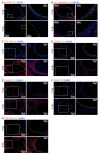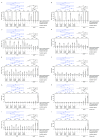Vascular Damage in the Aorta of Wild-Type Mice Exposed to Ionizing Radiation: Sparing and Enhancing Effects of Dose Protraction
- PMID: 34771507
- PMCID: PMC8582417
- DOI: 10.3390/cancers13215344
Vascular Damage in the Aorta of Wild-Type Mice Exposed to Ionizing Radiation: Sparing and Enhancing Effects of Dose Protraction
Abstract
During medical (therapeutic or diagnostic) procedures or in other settings, the circulatory system receives ionizing radiation at various dose rates. Here, we analyzed prelesional changes in the circulatory system of wild-type mice at six months after starting acute, intermittent, or continuous irradiation with 5 Gy of photons. Independent of irradiation regimens, irradiation had little impact on left ventricular function, heart weight, and kidney weight. In the aorta, a single acute exposure delivered in 10 minutes led to structural disorganizations and detachment of the aortic endothelium, and intima-media thickening. These morphological changes were accompanied by increases in markers for profibrosis (TGF-β1), fibrosis (collagen fibers), proinflammation (TNF-α), and macrophages (F4/80 and CD68), with concurrent decreases in markers for cell adhesion (CD31 and VE-cadherin) and vascular functionality (eNOS) in the aortic endothelium. Compared with acute exposure, the magnitude of such aortic changes was overall greater when the same dose was delivered in 25 fractions spread over 6 weeks, smaller in 100 fractions over 5 months, and much smaller in chronic exposure over 5 months. These findings suggest that dose protraction alters vascular damage in the aorta, but in a way that is not a simple function of dose rate.
Keywords: ApoE−/−; C57BL6/J; aged mice; aorta; fibrosis; inflammation; intima-media thickening; ionizing radiation; left ventricular function; vascular damage.
Conflict of interest statement
The authors declare no conflict of interest.
Figures




References
-
- Little M.P., Azizova T.V., Hamada N. Low- and Moderate-Dose Non-Cancer Effects of Ionizing Radiation in Directly Exposed Individuals, Especially Circulatory and Ocular Diseases: A Review of the Epidemiology. Int. J. Radiat. Biol. 2021;97:782–803. doi: 10.1080/09553002.2021.1876955. - DOI - PMC - PubMed
-
- ICRP ICRP Statement on Tissue Reactions/Early and Late Effects of Radiation in Normal Tissues and Organs–Threshold Doses for Tissue Reactions in a Radiation Protection Context: ICRP Publication 118. [(accessed on 28 September 2021)];Ann. ICRP. 2012 41:1–322. doi: 10.1016/j.icrp.2012.02.001. Available online: https://journals.sagepub.com/doi/pdf/10.1177/ANIB_41_1-2. - DOI - DOI - PubMed
LinkOut - more resources
Full Text Sources
Miscellaneous

